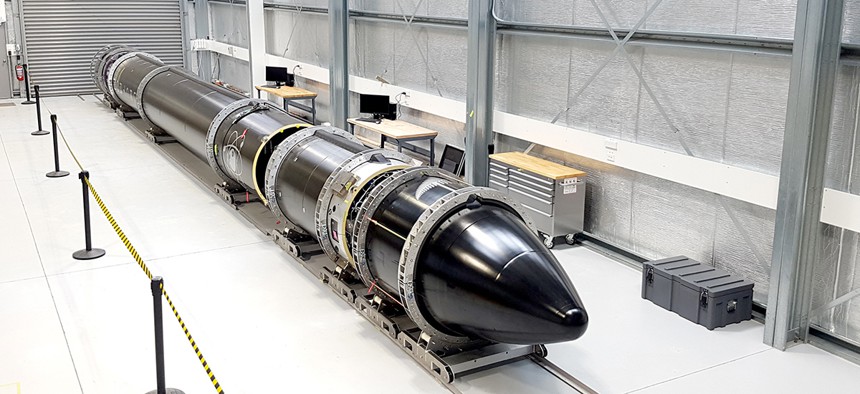The Rocket Startup About to Eat Elon Musk’s Lunch

Rocket Lab
Rocket Lab is aiming to put small satellites in low Earth orbit at a fraction of the cost of even SpaceX
With its Thursday announcement of a successful launch of the Electron rocket, a small New Zealand startup changed the private space race.
#ItsaTest pic.twitter.com/KRo1iBB1wK
— Rocket Lab (@RocketLabUSA) May 25, 2017
What’s special about Rocket Lab?
The company is promising to put objects into space for less than $5 million per launch. That’s about one-tenth as much as its nearest rival, SpaceX, which claims an average launch cost of $57 million, and a tiny fraction of the $225 million price tag for a launch by United Launch Alliance, the U.S. industry leader made up of Boeing and Lockheed Martin. (ULA says its launches will eventually cost closer to $100 million.) Rocket Lab hit space for a fraction of that, and while they didn’t hit formal “orbit,” that’s just a formality of scaling.
How does Rocket Lab do it? Advancements in batteries and 3-D printing allow simpler design and manufacturing. The company 3-D-prints virtually every component on its Rutherford engine, the engine featured on the Electron. That means fewer parts and components because each piece fits together better.
Rocket Lab also uses electric lithium batteries to power the pumps that push the liquid oxygen (which works as an oxidizing agent) and the kerosene into the rocket’s combustion chamber. Traditional rocket engine designs rely on a byzantine web of tubes, turbopumps and secondary motors (needing their own liquid fuel) just to pump the fluids into the chamber. The Rutherford’s design is both simpler and lighter, reducing cost.
“It’s really only the advancement in battery technology that has enabled us to go to electric turbopumps,” Rocket Lab founder Peter Beck told Popular Science at the engine’s unveiling. “Even three or four years ago, the technology wouldn’t have been sufficient. But there have been enormous advances in a short time period, and now the electric motor is about 95 percent efficient, versus the 60 percent efficiency of the gas motor.”
The Electron rocket is largely built of lightweight carbon composite material, like the General Atomics MQ-9 Reaper and similar drones, tweaked to hold liquid oxygen.
That gives the 55-foot rocket “a dry mass equal to less than a Mini Cooper,” Beck said. (That would be under 1.25 tons.)
The Electron is not the answer for every outfit looking to stick something in space. Its payload is limited to about 500 pounds, too small to loft craft like NASA’s LISA Pathfinder or any of the Air Force’s Air Force’s Space Based Infrared System satellites, and, as stated, after upscaling it can only reach low earth orbit, right now.
But Rocket Lab is still finding customers in the national security space, such as satellite startup Planet Labs, whose low-Earth-orbit constellation of mini satellites photograph the entire surface of the globe every 24 hours. It’s a useful capability to have if you’re tracking, say, North Korean tunnel construction or the movement of Russian military assets into Belarus. That’s why the National Geospatial-Intelligence Agency inked a deal with Planet Labs in October.
“This is providing us the ability to augment intelligence, providing us the ability and have resilience,” NGA’s Chirag Parikh said late last year. “We will take the feeds that we can get from commercial capabilities in the marketplace.”
Granted, SpaceX can carry more weight on its rockets, but payload size could be much less of a factor in future satellite systems as miniaturization of component parts continues. That’s true even in the lens and telescope space. (For evidence of that, just Google “Interferometry” and look for contemporary results.
Satellites have long been getting small and more useful; Planet represents the continuation of a trend first observed by Gordon Moore in 1965: the shrinking of electronic devices as the number of transistors that can fit onto a silicon chip doubles every 18 months. What’s been missing is the ability to get them into space cheaply.
Putting satellites into orbit at less cost gives any nation an advantage over adversaries looking to take out those space-based assets. The more birds you have up, the smaller the disruption to your imaging activity when an enemy knocks them down or jams the signal.
Rocket Lab eventually wants to get to 50 launches a year. Tuesday’s launch showed that’s a reasonable goal, and arriving sooner than some more established players anticipated.
“We’re one of a few companies to ever develop a rocket from scratch and we did it in under four years. We’ve worked tirelessly to get to this point. We’ve developed everything in-house, built the world’s first private orbital launch range, and we’ve done it with a small team,” Beck said about the launch.
NEXT STORY: How Apple Watches Could Detect a Stroke






